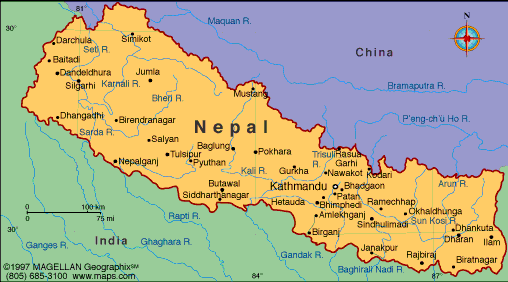About Nepal
Nepal is a landlocked country that is located in the South-Asia continent, bordered by the countries China and Asia. Nepal is the world's 93rd largest country by area with a total of 147,181 square kilometers. Nepal is considered a developing country with a population total of around 29 million people (CIA, 2015). The country of Nepal is divided into three topographical regions known as the Terai, Mountain and Hill regions (CIA, 2015). The Terai region of Nepal makes up a total of 23% of the total land and consists of the flatland areas. The Terai region is home to most of the population in Nepal and is where most of the farming activity takes place. The Mountain region of the country includes Mount Everest and the other seven of the world's ten highest peaks. The human inhabitation and economic activities, such as farming are very limited due to the climate and landscape features of the region. The Hills region in Nepal is the country’s most fertile and urbanized region, which consists of two major ranges of hills, commonly known as the Mahabharata Lekh and the Siwalik Range. The Hill region covers 68% of the total land in Nepal.

Agriculture In Nepal
Approximately 30% of the land in Nepal is used for agriculture and around 70% of Nepal’s population is employed in the agricultural sector. This accounts for 35% of Nepal’s Growth Domestic Product. The livestock subsector in Nepal contributes 24% towards the agriculture Growth Domestic product for the country (Pradhanang et al, 2015). The livestock subsector plays an important role in livelihood, food and nutritional security, and poverty alleviation (Pradhanang et al, 2015). Nepal depends on agriculture the most when it comes it income. Nepal has the second highest poverty rate, along with the lowest per capita income (Pyakuryal,2010). Farmers in Nepal don’t have access to things like new technologies, new seed varieties, and market opportunities, because of this agricultural production has decreased therefore increasing cases of hunger and undernourishment.

Figure 1: Map of Nepal (Source:http://www.infoplease.com/atlas/country/nepal.html)
Figure 2: Agriculture in Nepal (Source:http://sadpnepal.org/internshiptraining/)
Central Intelligence Agency. 2015. Retrieved November 18, 2016, from https://www.cia.gov/library/publications/the-world-factbook/geos/np.html
Pradhanang, B., & Pradhanang, S. (2015). Retrieved November 23, 2016, from http://sfx.scholarsportal.info.subzero.lib.uoguelph.ca/guelph/docview/1672889668?accountid=11233
Pyakuryal, B. (2010). Retrieved November 24, 2016, from http://www.sciencedirect.com.subzero.lib.uoguelph.ca/science/journal/03069192